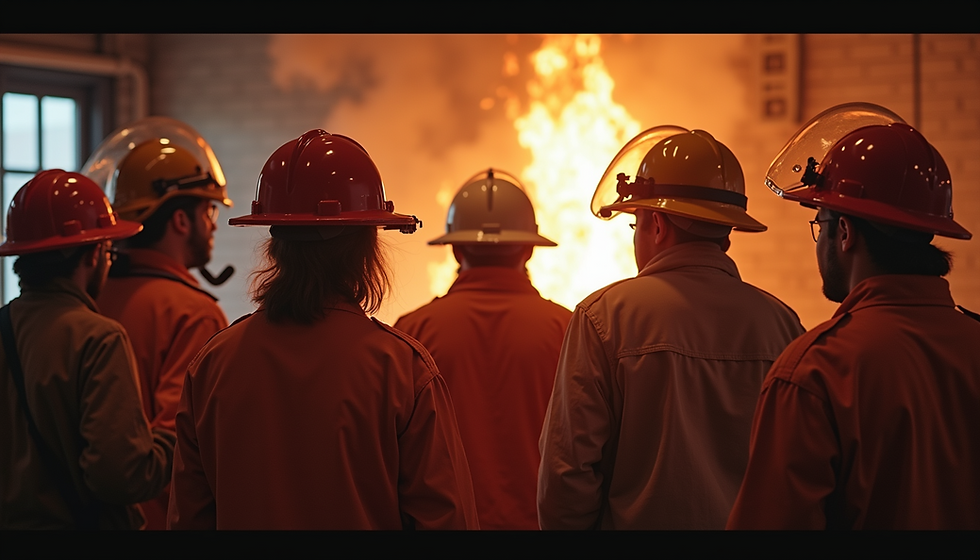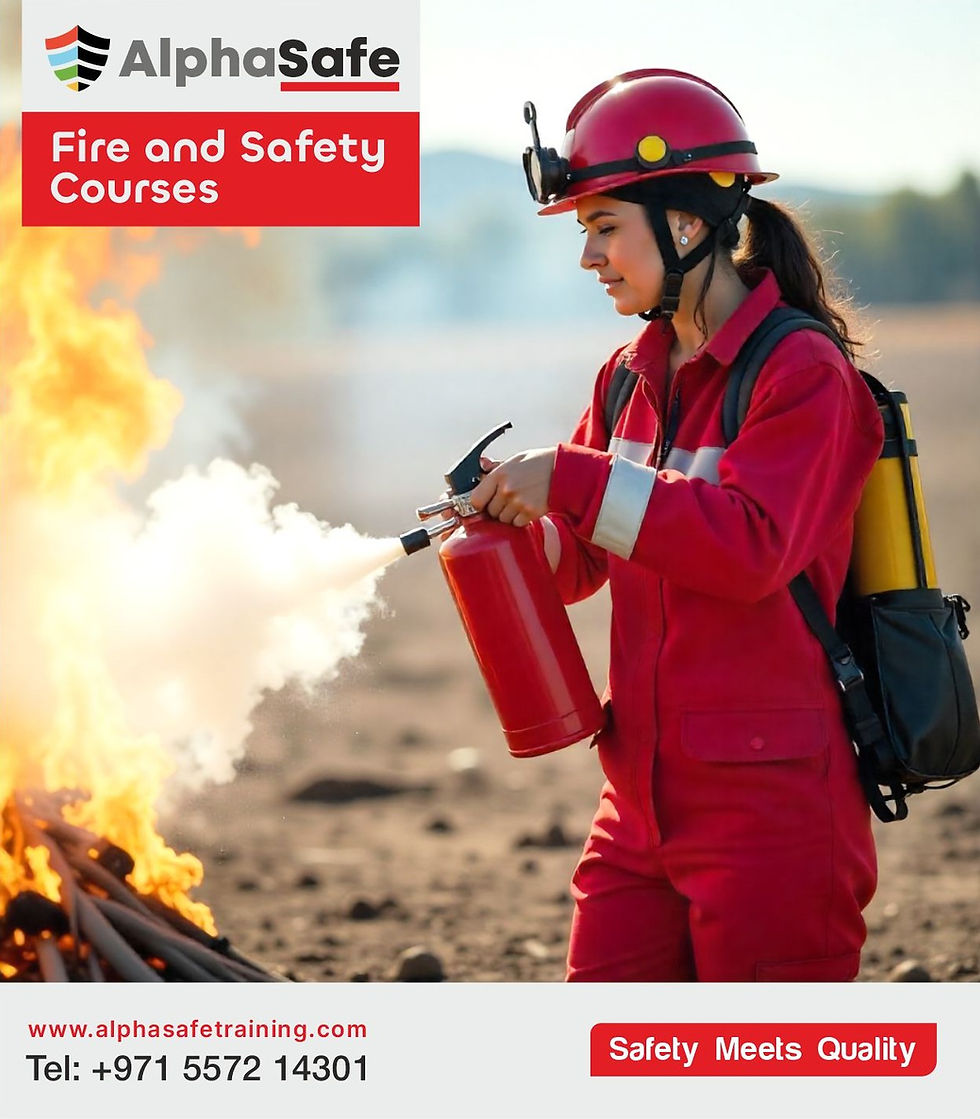Comprehensive Fire Safety Training Explained
- sreenath e.p
- 6 hours ago
- 4 min read
Fire safety is a critical aspect of any workplace or organization. Understanding how to prevent fires, respond effectively during emergencies, and ensure the safety of everyone involved is essential. In this post, I will explain the key components of comprehensive fire safety training, focusing on practical knowledge and actionable steps. This information is designed to help organizations and individuals improve their safety standards and compliance.
Understanding Fire Safety Essentials
Fire safety essentials cover the fundamental principles and practices that reduce the risk of fire and protect lives and property. These essentials include:
Fire prevention: Identifying and controlling fire hazards.
Fire detection: Using alarms and sensors to detect fires early.
Fire response: Knowing how to act quickly and safely during a fire.
Evacuation procedures: Planning and practicing safe exits.
Use of firefighting equipment: Understanding how to operate extinguishers and other tools.
Each of these elements plays a vital role in creating a safe environment. For example, fire prevention might involve regular inspections of electrical wiring or proper storage of flammable materials. Fire detection systems must be maintained and tested regularly to ensure they function correctly.
Key Components of Effective Fire Safety Training
Effective fire safety training equips participants with the knowledge and skills to handle fire emergencies confidently. The training should be comprehensive, covering both theory and practical exercises. Here are the main components:
Fire Awareness and Risk Assessment
Trainees learn to identify potential fire hazards in their environment. This includes understanding common causes of fire such as electrical faults, smoking, and improper storage of combustible materials.
Fire Prevention Techniques
Practical advice on reducing fire risks, such as maintaining clear escape routes, proper housekeeping, and safe use of electrical appliances.
Emergency Procedures and Evacuation Plans
Clear instructions on what to do when a fire is detected. This includes raising alarms, notifying emergency services, and following evacuation routes.
Use of Firefighting Equipment
Hands-on training with fire extinguishers, fire blankets, and hose reels. Trainees learn how to select the right extinguisher type and operate it safely.
First Aid and Rescue Techniques
Basic first aid for burns and smoke inhalation, as well as safe methods to assist others during evacuation.
Legal and Regulatory Compliance
Understanding local fire safety laws and regulations to ensure organizational compliance.
This structured approach ensures that participants are not only aware of fire risks but also prepared to act effectively.
Practical Fire Safety Training in Action
To make fire safety training truly effective, practical exercises are essential. These exercises simulate real-life scenarios and help reinforce learning. For example:
Fire drills: Regularly scheduled drills help familiarize everyone with evacuation routes and procedures. They also test the effectiveness of alarm systems and staff readiness.
Extinguisher practice: Trainees get hands-on experience using different types of fire extinguishers on controlled fires.
Scenario-based training: Role-playing exercises where participants respond to various fire situations, such as a kitchen fire or electrical fire.
These activities build confidence and muscle memory, which are crucial during actual emergencies. Organizations should schedule these sessions periodically and update training materials to reflect any changes in fire safety standards.
Why Fire Safety Training Matters for Organizations
Fire safety training is not just a regulatory requirement; it is a vital investment in the safety and well-being of employees and visitors. Here are some reasons why it matters:
Protects lives: Proper training reduces panic and confusion during emergencies, increasing the chances of safe evacuation.
Minimizes property damage: Quick and effective response can prevent fires from spreading and causing extensive damage.
Ensures legal compliance: Many jurisdictions require organizations to provide fire safety training and maintain records.
Enhances reputation: Demonstrating a commitment to safety builds trust with clients, partners, and employees.
Reduces insurance costs: Insurers often offer lower premiums to organizations with robust safety programs.
For organizations in Dubai and the UAE, partnering with a reputable training provider like Alphasafe Training Centre L.L.C ensures access to quality education and certification that meets local standards.
Implementing a Fire Safety Program
Implementing a fire safety program involves several steps to ensure ongoing effectiveness:
Assessment and Planning
Conduct a thorough fire risk assessment to identify hazards and vulnerabilities. Develop a fire safety plan tailored to the specific needs of the organization.
Training and Education
Enroll staff in certified fire safety training courses. Provide refresher sessions regularly to keep knowledge current.
Installation and Maintenance of Equipment
Ensure fire alarms, extinguishers, and sprinkler systems are installed correctly and maintained regularly.
Communication and Signage
Display clear fire safety signs and instructions throughout the premises. Communicate emergency procedures to all occupants.
Regular Drills and Reviews
Schedule fire drills and review the effectiveness of the fire safety plan. Update procedures based on feedback and changes in the environment.
Documentation and Record Keeping
Maintain records of training, inspections, and incidents to demonstrate compliance and support continuous improvement.
By following these steps, organizations can create a safer workplace and reduce the risk of fire-related incidents.
Staying Prepared Beyond Training
Fire safety is an ongoing commitment. Even after completing formal training, it is important to:
Stay informed about new fire safety technologies and regulations.
Encourage a culture of safety where everyone feels responsible for fire prevention.
Regularly inspect and maintain fire safety equipment.
Review and update emergency plans as the organization grows or changes.
Continuous vigilance and proactive measures are key to maintaining a safe environment.
Fire safety is a critical responsibility that requires knowledge, preparation, and action. Comprehensive fire safety training provides the foundation for protecting lives and property. By understanding fire safety essentials and implementing effective programs, organizations can meet legal requirements and foster a culture of safety. For those seeking expert guidance and certification, partnering with a trusted provider like Alphasafe Training Centre L.L.C is a valuable step toward achieving these goals.




Comments